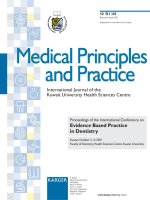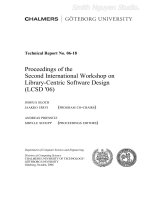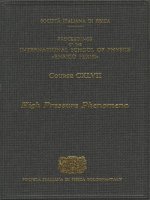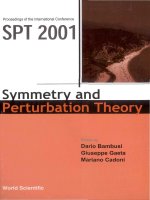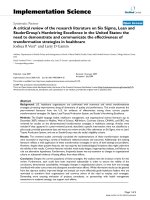Proceedings of the international conference on signal, networks, computing, and systems ICSNCS 2016, volume 2
Bạn đang xem bản rút gọn của tài liệu. Xem và tải ngay bản đầy đủ của tài liệu tại đây (9.97 MB, 336 trang )
Lecture Notes in Electrical Engineering 396
Daya K. Lobiyal
Durga Prasad Mohapatra
Atulya Nagar
Manmath N. Sahoo
Editors
Proceedings of
the International
Conference on Signal,
Networks, Computing,
and Systems
ICSNCS 2016, Volume 2
Lecture Notes in Electrical Engineering
Volume 396
Board of Series editors
Leopoldo Angrisani, Napoli, Italy
Marco Arteaga, Coyoacán, México
Samarjit Chakraborty, München, Germany
Jiming Chen, Hangzhou, P.R. China
Tan Kay Chen, Singapore, Singapore
Rüdiger Dillmann, Karlsruhe, Germany
Haibin Duan, Beijing, China
Gianluigi Ferrari, Parma, Italy
Manuel Ferre, Madrid, Spain
Sandra Hirche, München, Germany
Faryar Jabbari, Irvine, USA
Janusz Kacprzyk, Warsaw, Poland
Alaa Khamis, New Cairo City, Egypt
Torsten Kroeger, Stanford, USA
Tan Cher Ming, Singapore, Singapore
Wolfgang Minker, Ulm, Germany
Pradeep Misra, Dayton, USA
Sebastian Möller, Berlin, Germany
Subhas Mukhopadyay, Palmerston, New Zealand
Cun-Zheng Ning, Tempe, USA
Toyoaki Nishida, Sakyo-ku, Japan
Bijaya Ketan Panigrahi, New Delhi, India
Federica Pascucci, Roma, Italy
Tariq Samad, Minneapolis, USA
Gan Woon Seng, Nanyang Avenue, Singapore
Germano Veiga, Porto, Portugal
Haitao Wu, Beijing, China
Junjie James Zhang, Charlotte, USA
About this Series
“Lecture Notes in Electrical Engineering (LNEE)” is a book series which reports
the latest research and developments in Electrical Engineering, namely:
•
•
•
•
•
Communication, Networks, and Information Theory
Computer Engineering
Signal, Image, Speech and Information Processing
Circuits and Systems
Bioengineering
LNEE publishes authored monographs and contributed volumes which present
cutting edge research information as well as new perspectives on classical fields,
while maintaining Springer’s high standards of academic excellence. Also
considered for publication are lecture materials, proceedings, and other related
materials of exceptionally high quality and interest. The subject matter should be
original and timely, reporting the latest research and developments in all areas of
electrical engineering.
The audience for the books in LNEE consists of advanced level students,
researchers, and industry professionals working at the forefront of their fields. Much
like Springer’s other Lecture Notes series, LNEE will be distributed through
Springer’s print and electronic publishing channels.
More information about this series at />
Daya K. Lobiyal Durga Prasad Mohapatra
Atulya Nagar Manmath N. Sahoo
•
•
Editors
Proceedings of the
International Conference
on Signal, Networks,
Computing, and Systems
ICSNCS 2016, Volume 2
123
Editors
Daya K. Lobiyal
School of Computer and Systems Sciences
Jawaharlal Nehru University
New Delhi, Delhi
India
Atulya Nagar
Faculty of Science
Liverpool Hope University
Liverpool
UK
Durga Prasad Mohapatra
Department of Computer Science
and Engineering
National Institute of Technology
Rourkela, Odisha
India
Manmath N. Sahoo
Department of Computer Science
and Engineering
National Institute of Technology
Rourkela, Odisha
India
ISSN 1876-1100
ISSN 1876-1119 (electronic)
Lecture Notes in Electrical Engineering
ISBN 978-81-322-3587-3
ISBN 978-81-322-3589-7 (eBook)
DOI 10.1007/978-81-322-3589-7
Library of Congress Control Number: 2016942038
© Springer India 2016
This work is subject to copyright. All rights are reserved by the Publisher, whether the whole or part
of the material is concerned, specifically the rights of translation, reprinting, reuse of illustrations,
recitation, broadcasting, reproduction on microfilms or in any other physical way, and transmission
or information storage and retrieval, electronic adaptation, computer software, or by similar or dissimilar
methodology now known or hereafter developed.
The use of general descriptive names, registered names, trademarks, service marks, etc. in this
publication does not imply, even in the absence of a specific statement, that such names are exempt from
the relevant protective laws and regulations and therefore free for general use.
The publisher, the authors and the editors are safe to assume that the advice and information in this
book are believed to be true and accurate at the date of publication. Neither the publisher nor the
authors or the editors give a warranty, express or implied, with respect to the material contained herein or
for any errors or omissions that may have been made.
Printed on acid-free paper
This Springer imprint is published by Springer Nature
The registered company is Springer (India) Pvt. Ltd.
Preface
International Conference on Signal, Networks, Computing, and Systems (ICSNCS
2016), organized by School of Computer and Systems Sciences, Jawaharlal Nehru
University, India, during February 25–27, 2016, certainly marks a success toward
bringing researchers, academicians, and practitioners to the same platform. It is
indeed a pleasure to receive overwhelming response from researchers of premier
institutes of the country and abroad for participating in ICSNCS 2016, which makes
our endeavor successful. Being the first conference of its series, it was challenging
for us to broadcast the conference among researchers and scientists and to receive
their valuable works for review. A very systematic workflow by the committee has
made it possible. We have received 296 articles and have selected 73 articles of the
highest quality among them for presentation and publication through peer-review
done by at least two experts for each article. We are unable to accommodate many
promising works as we restricted our selection to limited articles which could be
elaborately presented in a three-day conference. We are thankful to have the advice
of dedicated academicians and experts from industry to organize the conference.
We thank all researchers who participated and submitted their valued works in our
conference. The articles presented in the proceedings discuss the cutting-edge
technologies and recent advances in the domain of the conference. We conclude
with our heartiest thanks to everyone associated with the conference and seeking
their support to organize the next editions of the conference in subsequent years.
New Delhi, India
Rourkela, India
Liverpool, UK
Rourkela, India
Daya K. Lobiyal
Durga Prasad Mohapatra
Atulya Nagar
Manmath N. Sahoo
v
Conference Organization
General Chair
Daya K. Lobiyal, Jawaharlal Nehru University, India
Organizing Chairs
Ram Shringar Rao, Ambedkar Institute of Advanced Communication Technologies
and Research, India
Sushil Kumar, Jawaharlal Nehru University, India
Buddha Singh, Jawaharlal Nehru University, India
Program Chairs
Manmath N. Sahoo, National Institute of Technology, Rourkela, India
Zaheeruddin, Jamia Millia Islamia University, India
Yulei Wu, University of Exeter, Exeter
Program Co-Chairs
Sandip Rakshit, Kaziranga University, Assam, India
Syed Rizvi, Pennsylvania State University, USA
Yogesh H. Dandawate, SMIEEE, Vishwakarma Institute of Information
Technology, India
vii
viii
Conference Organization
Publication Chairs
Soubhagya Sankar Barpanda, National Institute of Technology, Rourkela, India
Sambit Bakshi, National Institute of Technology, Rourkela, India
Area Chairs
ASIA: Ompraksh Kaiwartya, Faculty of Computing Universiti Teknologi, Malaysia
EUROPE: Atilla Elci, Aksaray University, Turkey
USA: Adam Schmidt, Poznan University of Technology, Poland
Technical Track Chairs
Signal: Binod K. Kanaujia, AIACTR, India
Networking: Sanjay K. Soni, Delhi Technological University, Delhi, India
Computing: Nanhay Singh, AIACTR, India
Systems: Naveen Kumar, Indira Gandhi National Open University, India
Web Chairs
Sanjoy Das, Galgotias University, India
Rahul Raman, National Institute of Technology, Rourkela, India
Technical Program Committee
Anand Paul, SMIEEE, Kyungpook National University, Republic of Korea
Andrey V. Savchenko, National Research University Higher School of Economics,
Russia
Ch. Aswani Kumar, Vellore Institute of Technology, India
Dilip Singh Sisodia, National Institute of Technology, Raipur, India
Ediz Saykol, Beykent University, Turkey
Flavio Lombardi, Roma Tre University of Rome, Italy
Jamuna Kanta Sing, SMIEEE, Jadavpur University, India
Jaya Sil, Bengal Engineering and Science University, India
Conference Organization
ix
Krishnan Nallaperumal, SMIEEE, Manonmaniam Sundaranar University, India
Lopamudra Chowdhury, Jadavpur University, India
Narayan C. Debnath, Winona State University, USA
Nidul Sinha, SMIEEE, National Institute of Technology, Silchar, India
Paulo Quaresma, University of Evora, Portugal
Patrick Siarry, SMIEEE, Université de Paris, France
Pradeep Singh, National Institute of Technology, Raipur, India
Raghvendra Mall, University of Leuven, Belgium
Rajarshi Pal, Institute for Development and Research in Banking Technology, India
Sotiris Kotsiantis, University of Patras, Greece
Yogesh H. Dandawate, SMIEEE, Vishwakarma Institute of Information Technology,
Pune, India
Zhiyuan (Thomas) Tan, University of Twente, the Netherlands
Organizing Committee
Adesh Kumar, Shri Lal Bahadur Shastri Rashtriya Sanskrit Vidyapeetha, India
Ajay Sikandar, Jawaharlal Nehru University, India
Anil Kumar Sagar, Galgotias University, India
Arvind Kumar, Ambedkar Institute of Advanced Communication Technologies
and Research, India
Ashok Kumar Yadav, Amity School of Engineering and Technology, India
Indrani Das, Jawaharlal Nehru University, India
Kamlesh Kumar Rana, Galgotias College of Engineering and Technology (GCET),
India
Karan Singh, Jawaharlal Nehru University, India
Mahendra Ram, Jawaharlal Nehru University, India
Meenakshi Sihag, Guru Tegh Bahadur Institute of Technology, India
Prashant Singh, Northern India Engineering College, India
Rajesh Kumar Yadav, Delhi Technological University, India
Rameshwar Lal Ujjwal, Guru Gobind Singh Indraprastha University, India
Sanjeev Kumar, Ambedkar Institute of Advanced Communication Technologies
and Research, India
Shailender Kumar, Ambedkar Institute of Advanced Communication Technologies
and Research, India
Sunil Kumar, Jawaharlal Nehru University, India
Suresh Kumar, Ambedkar Institute of Advanced Communication Technologies
and Research, India
x
Conference Organization
External Reviewers
Ajay Shankar Shukla, Central Council for Research in Ayurvedic Sciences, India
Amar Jeet Singh, Himachal Pradesh University, India
R. Kingsy Grace, Anna University, India
Shiv Prakash, Indian Institute of Technology, Delhi, India
Snehasis Banerjee, Tata Consultancy Services Research, India
Taymaz Farshi, Gazi University, Turkey
Omprakash Kaiwartya, Jawaharlal Nehru University, India
Xavier Bellekens, University of Strathclyde, Glasgow
Contents
Part I
Advanced Computing Paradigms
Interactions with Human CD4 Protein Leads to Helix-to-Coil
Transition in HIV-gp120 Aiding CCR5 Attachment and Viral Entry:
An In Silico Structural Biology Approach for AIDS . . . . . . . . . . . . . . .
Sujay Ray and Arundhati Banerjee
A Support Vector Machine Approach for LTP Using
Amino Acid Composition . . . . . . . . . . . . . . . . . . . . . . . . . . . . . . . . . .
N. Hemalatha and N.K. Narayanan
Load Balancing Challenges in Cloud Computing: A Survey . . . . . . . . .
Rafiqul Zaman Khan and Mohammad Oqail Ahmad
3
13
25
Physiological Modeling of Retinal Layers for Detecting the Level
of Perception of People with Night Blindness . . . . . . . . . . . . . . . . . . . .
T. Rajalakshmi and Shanthi Prince
33
An Improved Encryption and Signature Verification ECC Scheme
for Cloud Computing . . . . . . . . . . . . . . . . . . . . . . . . . . . . . . . . . . . . .
Shweta Kaushik and Charu Gandhi
43
Implementing a Web-Based Simulator with Explicit Neuron
and Synapse Models to Aid Experimental Neuroscience
and Theoretical Biophysics Education . . . . . . . . . . . . . . . . . . . . . . . . .
Aadityan Sridharan, Hemalatha Sasidharakurup, Dhanush Kumar,
Nijin Nizar, Bipin Nair, Krishnashree Achuthan and Shyam Diwakar
57
On Intuitionistic Fuzzy Soft Sets and Their Application
in Decision-Making . . . . . . . . . . . . . . . . . . . . . . . . . . . . . . . . . . . . . . .
B.K. Tripathy, R.K. Mohanty and T.R. Sooraj
67
CheckPDF: Check What is Inside Before Signing a PDF Document . . .
Bhavya Bansal, Ronak Patel and Manik Lal Das
75
xi
xii
Contents
Kinematic Analysis of a Two-Wheeled Self-Balancing
Mobile Robot . . . . . . . . . . . . . . . . . . . . . . . . . . . . . . . . . . . . . . . . . . .
Animesh Chhotray, Manas K. Pradhan, Krishna K. Pandey
and Dayal R. Parhi
Program Code Understandability and Authenticating Code
Predicting Systems: A Metric-Based Approach. . . . . . . . . . . . . . . . . . .
Pooja Jha and K. Sridhar Patnaik
87
95
Fuzzy Sliding Mode-Based STATCOM for Stability and Reactive
Power Compensation in DG-Based Power System . . . . . . . . . . . . . . . . 105
Asit Mohanty, Meera Viswavandya, Sthitapragyan Mohanty
and Pragyan Paramita
ANFIS-Based Controller for DFIG-Based Tidal Current
Turbine to Improve System Stability . . . . . . . . . . . . . . . . . . . . . . . . . . 115
Asit Mohanty, Meera Viswavandya, Sthitapragyan Mohanty
and Pragyan Paramita
Design of Reversible Floating Point Adder for DSP Applications. . . . . . 123
A.N. Nagamani, C.K. Kavyashree, R.M. Saraswathy, C.H.V. Kartika
and Vinod Kumar Agrawal
Navigation of Mobile Robot Using Type-2 FLC . . . . . . . . . . . . . . . . . . 137
Krishna Kant Pandey, Anish Pandey, Animesh Chhotray
and Dayal R. Parhi
Analysis of the Complexity of Brain Under Mobile Phone
Radiation Using Largest Lyapunov Exponent . . . . . . . . . . . . . . . . . . . 147
C.K. Smitha and N.K. Narayanan
A Review of Bio-Inspired Computing Methods and Potential
Applications . . . . . . . . . . . . . . . . . . . . . . . . . . . . . . . . . . . . . . . . . . . . 155
Amrita Chakraborty and Arpan Kumar Kar
An Effective Task Scheduling Approach for Cloud Computing
Environment . . . . . . . . . . . . . . . . . . . . . . . . . . . . . . . . . . . . . . . . . . . 163
Jyoti Gupta, Md. Azharuddin and Prasanta K. Jana
Construct-Based Sentiment Analysis Model . . . . . . . . . . . . . . . . . . . . . 171
Smriti Singh, Jitendra Kumar Rout and Sanjay Kumar Jena
Part II
Methodologies for Systems Design
Effect of Delay Approximation Using Pade Technique on Controller
Performance Designed for a SOPDT Model . . . . . . . . . . . . . . . . . . . . . 181
Pradeep Kumar Juneja, Nidhi Jain, Mayank Chaturvedi
and Sameer Kumar Singh
Contents
xiii
Neuro-Fuzzy Controller Design for MIMO Boiler Turbine Process . . . . 189
Sandeep Kumar Sunori, Shweta Shree, Ajay Kumar Maurya
and Pradeep Juneja
Predictive Control System Design for Lime Kiln Process . . . . . . . . . . . 197
Sandeep Kumar Sunori, Vimal Singh Bisht, Mohit Pant
and Pradeep Juneja
Design of Time-Delay Compensator for a FOPDT Process Model . . . . . 205
Mayank Chaturvedi, Prateeksha Chauhaan and Pradeep K. Juneja
A Concept for Test Case Prioritization Based upon the Priority
Information of Early Phase . . . . . . . . . . . . . . . . . . . . . . . . . . . . . . . . . 213
Sushant Kumar, Prabhat Ranjan and R. Rajesh
MEMS-Based Phase Shifters for Phased Array Applications
Fully Integrated on PCB Substrates. . . . . . . . . . . . . . . . . . . . . . . . . . . 225
Amrita Chakraborty and Arpan Kumar Kar
A Novel Multipath Mitigation Technique for SPSGPS
Receivers in Indian Urban Canyons. . . . . . . . . . . . . . . . . . . . . . . . . . . 233
Bharati Bidikar, G. Sasibhushana Rao, L. Ganesh
and M.N.V.S. Santosh Kumar
Controller Design for a TOPDT Process Model Using Integral
Error-Based Tuning Techniques . . . . . . . . . . . . . . . . . . . . . . . . . . . . . 241
Alka Patel, Pradeep Kumar Juneja, Mayank Chaturvedi and Jyoti Patel
Effect of Variation in Filter Coefficients for Different PID
Controller Structures on Performance of SOPDT Process. . . . . . . . . . . 249
Mayank Chaturvedi and Pradeep K. Juneja
Controller Capability Comparison for a Delayed First-Order
Process Model . . . . . . . . . . . . . . . . . . . . . . . . . . . . . . . . . . . . . . . . . . 255
Pradeep Kumar Juneja, Mayank Chaturvedi and Manik Gupta
Optimization Study on Quarter Car Suspension System
by RSM and Taguchi . . . . . . . . . . . . . . . . . . . . . . . . . . . . . . . . . . . . . 261
M.B.S. Sreekar Reddy, P. Vigneshwar, D. RajaSekhar, Katiki Akhil
and P. Lakshmi Narayana Reddy
On Modeling and Analysis of Launch Vehicle System . . . . . . . . . . . . . 273
Abhaya Pal Singh and Himanshu Agrawal
Performance Evaluation of Tree-Based Classification
Techniques on Intrusion Dataset . . . . . . . . . . . . . . . . . . . . . . . . . . . . . 281
Moninder Kaur, Ramesh Kumar, Santosh Kumar Sahu
and Sanjay Kumar Jena
xiv
Contents
Kinematic Modeling and Simulation of Manipulator for Executing
Welding Operations with Arbitrary Weld Joint Profiles . . . . . . . . . . . . 291
B.B.V.L. Deepak, C.A. Rao, B.M.V.A. Raju and P.K. Singh
Modeling and Simulation for Conductivity of Germanium
and YBCO . . . . . . . . . . . . . . . . . . . . . . . . . . . . . . . . . . . . . . . . . . . . . 301
Rakesh Mohan Bhatt
Cryptoviral Extortion: Evolution, Scenarios, and Analysis . . . . . . . . . . 309
Bharti Nagpal and Vinayak Wadhwa
Utilization of Fractal Geometry for Phase Shifter Implementation. . . . . 317
Amrita Chakraborty and Arpan Kumar Kar
Simulation Studies for Delay Effect on Stability of a Canonical
Tank Process . . . . . . . . . . . . . . . . . . . . . . . . . . . . . . . . . . . . . . . . . . . 325
Mayank Chaturvedi, Pradeep K. Juneja, Neha Jadaun and A. Sharma
Current Signature Analysis of Single-Phase ZSI-Fed
Induction Motor Drive System . . . . . . . . . . . . . . . . . . . . . . . . . . . . . . 333
Vivek Sharma and Bhawana Negi
Kinematic Control of a Mobile Manipulator . . . . . . . . . . . . . . . . . . . . 339
B.B.V.L. Deepak, Dayal R. Parhi and Ravi Praksh
Author Index . . . . . . . . . . . . . . . . . . . . . . . . . . . . . . . . . . . . . . . . . . . 347
About the Editors
Dr. Daya K. Lobiyal is currently serving as Professor in School of Computer
and Systems Sciences in Jawaharlal Nehru University, India. His research works
have been published in many journals and conference proceedings. He is a Fellow
of Institution of Electronics and Telecommunication Engineers, India.
Prof. Durga Prasad Mohapatra received his Ph.D. from the Indian Institute of
Technology Kharagpur and is presently serving as Associate Professor in NIT
Rourkela, Odisha. His research interests include software engineering, real-time
systems, discrete mathematics, and distributed computing. He has published more
than 30 research papers in these fields in various international journals and conference proceedings. He has received several project grants from DST and UGC,
Government of India. He has received the Young Scientist Award for the year 2006
from Orissa Bigyan Academy. He has also received the Prof. K. Arumugam
National Award and the Maharashtra State National Award for outstanding research
work in Software Engineering for the years 2009 and 2010, respectively, from the
Indian Society for Technical Education (ISTE), New Delhi. He is going to receive
the Bharat Sikshya Ratan Award for significant contribution in academics awarded
by the Global Society for Health and Educational Growth, Delhi.
Prof. Atulya Nagar holds the Foundation Chair as Professor of Mathematical
Sciences at Liverpool Hope University where he is the Dean of Faculty of Science.
He has been the Head of Department of Mathematics and Computer Science since
December 2007. A mathematician by training, he is an internationally recognized
scholar working at the cutting edge of applied nonlinear mathematical analysis,
theoretical computer science, operations research, and systems engineering and his
work is underpinned by strong complexity-theoretic foundations. He has an
extensive background and experience of working in universities in UK and India.
He has edited volumes on Intelligent Systems and Applied Mathematics; he is the
Editor-in-Chief of the International Journal of Artificial Intelligence and Soft
Computing (IJAISC) and serves on editorial boards for a number of prestigious
journals such as the Journal of Universal Computer Science (JUCS). Professor
Nagar received a prestigious Commonwealth Fellowship for pursuing his Doctorate
xv
xvi
About the Editors
(D.Phil.) in Applied Non-Linear Mathematics, which he earned from the University
of York in 1996. He holds B.Sc. (Hons.), M.Sc., and M.Phil. (with Distinction)
from the MDS University of Ajmer, India.
Dr. Manmath N. Sahoo received his M.Tech and Ph.D. degrees in Computer
Science in the year 2009 and 2014, respectively, from National Institute of
Technology (NIT) Rourkela, India. He is Assistant Professor in the Department of
Computer Science and Engineering, NIT Rourkela, India. He has served as
reviewer, guest editor, track chair, and program chair in many reputed journals and
conferences. His research interests include mobile ad hoc networks, fault tolerance,
and sensor networks. He is a professional member of prestigious societies like
IEEE, CSI, and IEI.
Part I
Advanced Computing Paradigms
Interactions with Human CD4 Protein
Leads to Helix-to-Coil Transition
in HIV-gp120 Aiding CCR5 Attachment
and Viral Entry: An In Silico Structural
Biology Approach for AIDS
Sujay Ray and Arundhati Banerjee
Abstract Human immuno-deficiency virus (HIV) is assisted by its glycoprotein;
gp120 for its human host cell invasion via fusion to cause AIDS. Documentation
documents a structural change in gp120, after its first interaction with human CD4
protein which further attracts CCR5 protein, thereby paving its way for viral entry.
So, gp120 was homology modeled efficiently. Trio docking analysis led to the
disclosure of the responsible residues from protein complexes. Polar-charged
residues from CD4 protein played a pivotal role. The trio complex was optimized
and simulated. Conformational switches and other stability parameters for gp120
was computed, compared, and analyzed at three different stages; before any
interaction and after CD4 and CCR5 interaction separately. They were statistically
significant with an overall helix-to-coil transition.
Á
Á
Keywords Modeling Conformational switches Docked Protein–Protein interaction AIDS Stability parameters Biostatistics
Á
Á
Á
1 Introduction
In AIDS (acquired immuno-deficiency syndrome), HIV uses glycoprotein
(gp) subunit-120 to participate in the interaction with CD4 receptor on the host
target cell [1, 2]. A structural and conformational change occurs in gp120 protein.
This further helps to activate the binding of chemokine coreceptors (CCR5) to
S. Ray (&)
Department of Biochemistry and Biophysics, University of Kalyani,
Kalyani, WB, India
e-mail:
A. Banerjee
Department of Biotechnology, National Institute of Technology,
Durgapur, WB, India
e-mail:
© Springer India 2016
D.K. Lobiyal et al. (eds.), Proceedings of the International Conference
on Signal, Networks, Computing, and Systems, Lecture Notes
in Electrical Engineering 396, DOI 10.1007/978-81-322-3589-7_1
3
4
S. Ray and A. Banerjee
gp120 [3]. HIV thus invades into the cell [3]. T-cells compromise the immune
system, expire and secondary infection is caused because of HIV’s eventual
replication. However, detailed molecular level interaction between these proteins
along with analysis in the conformational variations in gp120 at three different
stages (before any interaction, after interacting with CD4 and further with CCR5
protein) has not been dealt with yet.
Therefore, this study involves primarily the homology modeling of gp120 from
human immuno-deficiency virus (HIV) and analysis of the 3D functional state of all
the essential proteins. After simulation, the protein–protein docking studies helped
to examine the residual contribution. Further, the study delved into the conformational alterations, energy calculations, net solvent accessibility, and electrostatic
surface potentials in the gp120 protein at each individual stage of interaction with
statistical significances. This is an unexplored and novel description where the
probe provides clear information regarding the respective residue level disclosure
for understanding the molecular background for HIV entry. The overall study
contributes to future molecular and therapeutic research.
2 Materials and Methods
2.1
Sequence-Template Exploration and Homology
Modeling for gp120 Protein
The amino acid sequence of human immuno-deficiency virus (HIV) protein from
Human Immuno-Deficiency Virus was extracted and obtained from Uniprot KB
(Accession No.: P03378). It was validated using NCBI too. Results from
PSI-BLASTP [4] against PDB helped to distinguish the templates for building the
homology model. The template was from Human Immuno-Deficiency Virus (PDB
code: 3J5M_A with 98 % query coverage sharing 72 % sequence identity).
For the homology modeling of gp120 protein, MODELLER9.14 software tool
[5] was operated. Root mean-squared deviations (RMSD) from the backbone
superimposition on its crystal template (i.e., A chain of 3J5M) was 0.244 Å from
both PyMOL [6].
2.2
Optimization, Refinement, and Stereochemical
Validation of the Structure
The modeled protein was subjected to ModLoop [7] and further ModRefiner tool
[8] to resolve the distortions in the loop regions and refinement in the 3D geometry
of gp120. A steady conformation [8] was achieved by overall energy optimization.
Energy minimization technique using CHARMM force field [9] was performed by
Interactions with Human CD4 Protein Leads …
5
steepest descend technique and conjugate gradient using Discovery studio software,
until the modeled gp120 structure attained a RMS value of 0.0001. Corroboration
of the stereochemical features of the modeled gp120 protein was performed with
the estimation of Verify3D [10] and ERRAT [11] values. Ramachandran Plot [12]
had zero residues in the unfavored regions.
2.3
Structure Analysis of gp120-CD4 Complex and Human
CCR5 Protein
The necessary search results for gp120-CD4 bound complex for the purpose of
effective cooperation of gp120 with human CD4, selected its X-ray crystal structure
from Homo sapiens, having PDB ID: 2B4C with chain G and C for gp120 protein
and human CD4 protein [13]. The entire protein complex of interest had 496 amino
acids. Search results for human CCR5 protein selected its X-ray crystal structure
from Homo sapiens having PDB ID: 4MBS, chain A [14]. It was 346 amino acid
residues long.
2.4
Protein–Protein Docking with Human CCR5 Protein
and Simulation
For the protein–protein interaction study of gp120-CD4 complex with human
CCR5 protein, the protein complex and human CCR5 protein was docked operating
Cluspro2.0 [15]. Preeminent cluster size among all the complexes was opted.
Two-step molecular dynamics simulation was performed to achieve a stable
conformation of the protein with a diminished overall energy. First, FG-MD
(fragment-guided molecular-dynamics) [16] aided to reconstruct the energy funnel
via MD simulations. Next, this rebuilt simulated trio protein complex structure from
its fragments was subjected to Chiron Energy Minimization tool [17], to diminish
the overall energy using CHARMM force field [9] and perform Molecular
Dynamics [17]. Therefore, besides eliminating the steric clashes rapidly, minimal
deformation of the protein backbone was produced.
2.5
Conformational Variations and Stability
for the gp120 Protein
The conformational switching in the gp120 HIV protein was estimated and analyzed at its three different stages; before any kind of interaction (S1), after interacting with CD4 protein (S2) and after interacting with CCR5 protein (S3) further.
6
S. Ray and A. Banerjee
So, the individual secondary structure distribution was analyzed using DSSP
method [18] and PyMOL [6]. Documentation suggests [19] that increase in the
helical structures and β-sheets leads to stronger and better interaction.
At three different stages; S1, S2, and S3, the stability and strength of the protein
was explored by evaluating the free energy of folding (using VADAR2.0 [20]) and
net area of solvent accessibility [21] of the individual gp120 protein. The surface
electrostatic potential for all the three gp120 structures was generated through
vacuum electrostatics with the assistance of PyMOL [6].
2.6
Calculation of Interaction Patterns and Binding Modes
in the Complexes
Protein Interaction Calculator (P.I.C) web server [22] was operated to delve into the
responsible relevant amino acid residues (specially, predominant ionic interactions
[23]) participating in the protein–protein complexes from their individual positions.
2.7
Evaluation and Substantiation Through Statistical
Significance
For the purpose of statistical significance analysis and substantiation of the estimated outcomes, the paired T-test was evaluated. The difference between the two
means turns-out to be statistically significant (P < 0.05) and thus, validates the
outcomes.
3 Results
3.1
Structural Portrayal of the Human Immuno-Deficiency
Virus gp120
The functionally potent 3D-modeled structure of the human immuno-deficiency
virus gp120 protein was 478 amino acids long. The modeled protein was akin to its
crystal template belonging from Human Immuno-deficiency Virus (PDB code:
3J5M, chain A). It comprises mainly 7 sets of α-helices interspersed with 21 sets of
parallel and anti-parallel β-sheets. The structure is well illustrated in Fig. 1 with
α-helices and β-sheets in marine blue and yellow shades connected by red-shaded
coils.
Interactions with Human CD4 Protein Leads …
7
Fig. 1 HIV gp120 protein with α-helices, β-sheets and coils in marine-blue, yellow and red
shades. Interacting residues from gp120 are labeled. CCR5 and CD4 in pink and green shades
(colour online)
3.2
Analysis of Conformational Transitions in gp120
The conformational switching in the gp120 HIV protein at S1, S2, and S3 stages
was evaluated and compared. Figure 2 represents the conformational alterations of
gp120.
3.3
3.3.1
Stability Analysis Deductions for gp120 Protein
Estimation of Free Energy of Folding, Net Solvent Accessibility,
and Electrostatic Potential on gp120 Protein Surface
After the two interactions, the free energy of folding and net solvent accessible area
was observed to get an abrupt increase and decrease (respectively). Thus, it
apprehends the structure to become more unstable (Table 1) but interact firmly for
the viral entry to occur efficiently.
Fascinatingly, the alteration in the vacuum electrostatic potential calculation
from ±68.740 to ±64.562 to ±53.640 (as in Fig. 3), also infers the gp120 protein
to become more unstable and be benefitted by the CD4 and CCR5 proteins individually for the viral entry via membrane fusion (Fig. 3).
8
S. Ray and A. Banerjee
Fig. 2 Conformational switches in gp120 at three different stages of interaction
Table 1 Stability calculation of gp120 protein after duo and trio protein complex formation
Stability parameters
gp120 single
gp120 duo
complex
gp120 trio
complex
Free energy of folding
Net solvent accessible
area
−421.49 kcal/mol
26258.74 Å2
−271.36 kcal/mol
19819.41 Å2
−235.45 kcal/mol
18366.99 Å2
Fig. 3 Comparative view of the surface electrostatic potential change on the surfaces of gp120
3.4
Analysis in Docked Protein–Protein Interactions
The comparative analysis for interaction between essentially paramount gp120 and
CD4 protein from the gp120-CD4 complex and gp120-CD4-CCR5 complex
(Table 2 and Fig. 1) revealed that the interaction grew stronger in the trio complex.
Interactions with Human CD4 Protein Leads …
9
Table 2 Ionic interactions among gp120 and CD4 after the duo and trio complex formation
Position
gp120-CD4
14
130
210
289
gp120-CD4-CCR5
23
289
50
210
130
14
Protein G and Protein C represents
3.5
Residue
Protein
LYS
G
LYS
G
ASP
G
ASP
G
GLU
G
ASP
G
ASP
G
ASP
G
LYS
G
LYS
G
HIV gp120 protein and
Position
410
410
381
357
345
357
380
381
410
410
human CD4
Residue
Protein
ASP
C
ASP
C
ARG
C
LYS
C
LYS
C
LYS
C
ARG
C
ARG
C
ASP
C
ASP
C
protein respectively
Substantiation Through Statistical Significance
All the estimated outcomes were observed to statistically significant (P < 0.5). The
paired T-test calculations revealed P = 0.010245, P = 0.024431 and P = 0.031382
for the free energy of folding, net solvent accessibility area, and conformational
switching to coils, respectively.
4 Discussion
In the current scenario, the functional tertiary modeled 3D protein structure of HIV
gp120 was efficiently built. Further, the gp120–CD4 complex was docked with
CCR5. The statistically significant conformational switches after simulation disclosed that there was a shift from helix-to-coil (predominant) as well as from
β-sheets-to-coils in gp120 protein. Furthermore, statistically significant decrease in
electrostatic potential along with altered free energy of folding disclosed the
instability of gp120 protein after the trio interaction. Four ionic strong interactions
were observed in the duo complex (Table 2) which increased to net six, after the
interaction of the duo protein complex with CCR5 (Table 2). From the duo complex, predominantly, Asp410 formed solely two ionic interactions from CD4 with
Lys14 and Lys130 of gp120 protein. On the other hand, from the trio complex,
leadingly, Asp410 formed uniquely two ionic interactions with Lys14 and Lys130
of gp120 protein. Additionally, from the trio complex two adjacent residues;
Arg380 and Arg381 from CD4 interacted with Asp50 and Asp210 of gp120. The
stronger interaction is further affirmed from the abrupt decrease in solvent accessible area for gp120 after trio complex formation. Altogether, it led to instability in
gp120 protein with a stronger interaction after the participation of CCR5 to perform
the viral entry into human host.
10
S. Ray and A. Banerjee
This residual-level in silico study to scrutinize the basis of the interaction and
conformational switches presents to be one of the most crucial zones. This computational investigation therefore, also delves into the disclosure of the residual
participation, binding demonstration, and analysis of the stability parameters in
gp120 at different stages of interaction for the viral entry to cause deadly disease
like AIDS. It prompts with an outlook for the future therapeutic research in a
distinct mode.
5 Conclusion and Future Prospect
The cooperative participation of the residues from the two essential proteins (gp120
and CD4) for HIV entry and AIDS was the chief focus of this current study.
Furthermore, the conformational switches in gp120 at three distinct stages and
stability parameters unveiled the instability of gp120 for the viral entry in AIDS
consequently. Therefore, the present study indulged into the molecular and computational basis of HIV entry. The structural and computational molecular contribution of gp120 and its interactions was essential to be elucidated for instigating the
future clinical progress in new therapeutics for AIDS.
Acknowledgments Authors are thankful for the immense help by Dr. Angshuman Bagchi,
Assistant Professor, Department of Biochemistry and Biophysics, University of Kalyani, Kalyani,
Nadia, India. Moreover, our deepest regards would be for the Department of Biotechnology,
National Institute of Technology Durgapur as well as the Department of Biotechnology, Bengal
College of Engineering and Technology, Durgapur for their immense support.
References
1. Alain, Bernard: Leucocyte typing: human leucocyte differentiation antigens detected by
monoclonal antibodies: specification, classification, nomenclature: [report on the first
international references workshop sponsored by INSERM, WHO and IUIS]. Berlin:
Springer. pp. 45–48 (1984) ISBN 0-387-12056-4.
2. Kwong, P.D., Wyatt, R., Robinson, J., Sweet, R.W., Sodroski, J., Hendrickson, W.A.:
Structure of an HIV gp120 envelope glycoprotein in complex with the CD4 receptor and a
neutralizing human antibody. Nature. 393 (6686), 648–59 (1998) doi:10.1038/31405.
PMID9641677.
3. Dalgleish, A.G., Beverley, P.C., Clapham, P.R., Crawford, D.H., Greaves, M.F., Weiss, R.A.:
The CD4 (T4) antigen is an essential component of the receptor for the AIDS retrovirus.
Nature. 312 (5996), 763–7 (1984).
4. Altschul, S.F., et al.: Basic local alignment search tool. Journal of Molecular Biology.
25, 403–410 (1990).
5. Sali, A., Blundell, T.L.: Comparative protein modelling by satisfaction of spatial restraints.
Journal of Molecular Biology. 234, 779–815 (1993).
6. DeLano, W.L.: The PyMOL Molecular Graphics System DeLano Scientific, San Carlos, CA,
USA (2002) doi:10.1093/nar/gki408.
